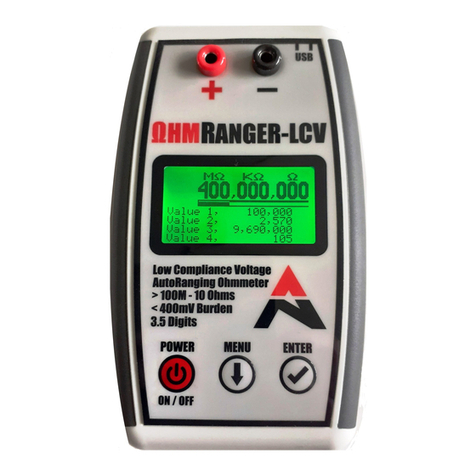3
OR-01 Instruction Manual V1.0 dated 14 Mar 22 –OR Software V2.20 and above
TABLE OF CONTENTS
1Preface................................................................................................................................5
1.1 The User..............................................................................................................................5
1.2 Conventions Used in This Manual.......................................................................................5
1.3 Explanation of Safety Warnings...........................................................................................5
1.4 Obtaining Documentation and Information..........................................................................5
2ΩhmRanger-LCV™ ............................................................................................................6
2.1 Utility and Employment........................................................................................................6
2.2 Theory of Operation.............................................................................................................6
2.3 Technical Data.....................................................................................................................8
2.4 Compliance..........................................................................................................................9
2.5 Guide to Product..................................................................................................................9
2.6 Understanding the User Interface........................................................................................9
2.7 Device Set-Up....................................................................................................................10
2.8 ΩhmRanger-LCV™ Menu Structure..................................................................................12
3Safety................................................................................................................................15
3.1 Using ΩhmRanger-LCV™ Safely ......................................................................................15
3.2 Guide to Graphical Symbols..............................................................................................16
4Taking Manual Readings ................................................................................................18
4.1 Switch ΩhmRanger-LCV™ ON .........................................................................................18
4.2 Automatic Range-Switching...............................................................................................18
4.3 The Signal to Noise Ratio (SNR).......................................................................................18
4.4 Switching ΩhmRanger-LCV™ OFF...................................................................................19
5Getting Connected - taking PC-Controlled Readings & SCPI Commands................20
5.1 SCPI Mandated Commands:.............................................................................................20
5.2 SCPI Required Commands: ..............................................................................................21
5.3 Device Commands (Routine Use).....................................................................................21
5.4 Device Commands for Advanced Use only (not normally required)..................................23
6Storage, Transportation and Disposal ..........................................................................25
6.1 Storage ..............................................................................................................................25
6.2 Packaging and Transportation...........................................................................................25
6.3 Disposal.............................................................................................................................25






























